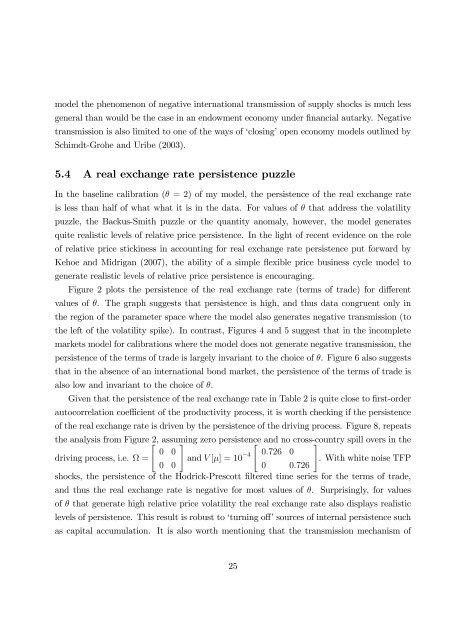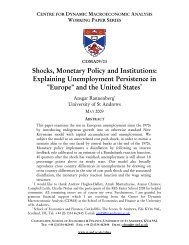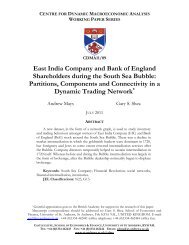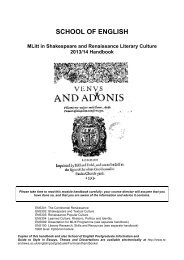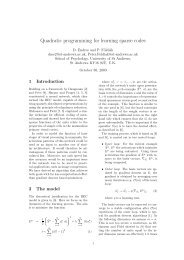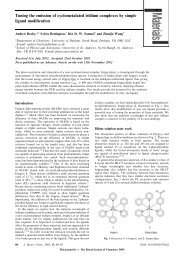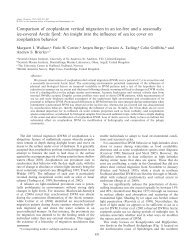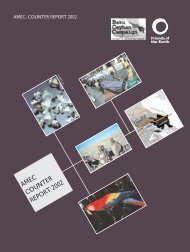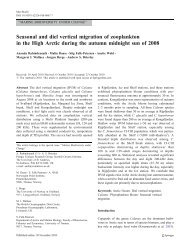Exchange rate dynamics, asset market structure and the role of the ...
Exchange rate dynamics, asset market structure and the role of the ...
Exchange rate dynamics, asset market structure and the role of the ...
Create successful ePaper yourself
Turn your PDF publications into a flip-book with our unique Google optimized e-Paper software.
model <strong>the</strong> phenomenon <strong>of</strong> negative international transmission <strong>of</strong> supply shocks is much less<br />
general than would be <strong>the</strong> case in an endowment economy under …nancial autarky. Negative<br />
transmission is also limited to one <strong>of</strong> <strong>the</strong> ways <strong>of</strong> ‘closing’open economy models outlined by<br />
Schimdt-Grohe <strong>and</strong> Uribe (2003).<br />
5.4 A real exchange <strong>rate</strong> persistence puzzle<br />
In <strong>the</strong> baseline calibration ( = 2) <strong>of</strong> my model, <strong>the</strong> persistence <strong>of</strong> <strong>the</strong> real exchange <strong>rate</strong><br />
is less than half <strong>of</strong> what what it is in <strong>the</strong> data. For values <strong>of</strong> that address <strong>the</strong> volatility<br />
puzzle, <strong>the</strong> Backus-Smith puzzle or <strong>the</strong> quantity anomaly, however, <strong>the</strong> model gene<strong>rate</strong>s<br />
quite realistic levels <strong>of</strong> relative price persistence. In <strong>the</strong> light <strong>of</strong> recent evidence on <strong>the</strong> <strong>role</strong><br />
<strong>of</strong> relative price stickiness in accounting for real exchange <strong>rate</strong> persistence put forward by<br />
Kehoe <strong>and</strong> Midrigan (2007), <strong>the</strong> ability <strong>of</strong> a simple ‡exible price business cycle model to<br />
gene<strong>rate</strong> realistic levels <strong>of</strong> relative price persistence is encouraging.<br />
Figure 2 plots <strong>the</strong> persistence <strong>of</strong> <strong>the</strong> real exchange <strong>rate</strong> (terms <strong>of</strong> trade) for di¤erent<br />
values <strong>of</strong> . The graph suggests that persistence is high, <strong>and</strong> thus data congruent only in<br />
<strong>the</strong> region <strong>of</strong> <strong>the</strong> parameter space where <strong>the</strong> model also gene<strong>rate</strong>s negative transmission (to<br />
<strong>the</strong> left <strong>of</strong> <strong>the</strong> volatility spike). In contrast, Figures 4 <strong>and</strong> 5 suggest that in <strong>the</strong> incomplete<br />
<strong>market</strong>s model for calibrations where <strong>the</strong> model does not gene<strong>rate</strong> negative transmission, <strong>the</strong><br />
persistence <strong>of</strong> <strong>the</strong> terms <strong>of</strong> trade is largely invariant to <strong>the</strong> choice <strong>of</strong> . Figure 6 also suggests<br />
that in <strong>the</strong> absence <strong>of</strong> an international bond <strong>market</strong>, <strong>the</strong> persistence <strong>of</strong> <strong>the</strong> terms <strong>of</strong> trade is<br />
also low <strong>and</strong> invariant to <strong>the</strong> choice <strong>of</strong> :<br />
Given that <strong>the</strong> persistence <strong>of</strong> <strong>the</strong> real exchange <strong>rate</strong> in Table 2 is quite close to …rst-order<br />
autocorrelation coe¢ cient <strong>of</strong> <strong>the</strong> productivity process, it is worth checking if <strong>the</strong> persistence<br />
<strong>of</strong> <strong>the</strong> real exchange <strong>rate</strong> is driven by <strong>the</strong> persistence <strong>of</strong> <strong>the</strong> driving process. Figure 8, repeats<br />
<strong>the</strong> analysis from Figure " 2, assuming # zero persistence " <strong>and</strong> no cross-country # spill overs in <strong>the</strong><br />
0 0<br />
driving process, i.e. = <strong>and</strong> V [] = 10 4 0:726 0<br />
. With white noise TFP<br />
0 0<br />
0 0:726<br />
shocks, <strong>the</strong> persistence <strong>of</strong> <strong>the</strong> Hodrick-Prescott …ltered time series for <strong>the</strong> terms <strong>of</strong> trade,<br />
<strong>and</strong> thus <strong>the</strong> real exchange <strong>rate</strong> is negative for most values <strong>of</strong> . Surprisingly, for values<br />
<strong>of</strong> that gene<strong>rate</strong> high relative price volatility <strong>the</strong> real exchange <strong>rate</strong> also displays realistic<br />
levels <strong>of</strong> persistence. This result is robust to ‘turning o¤’sources <strong>of</strong> internal persistence such<br />
as capital accumulation. It is also worth mentioning that <strong>the</strong> transmission mechanism <strong>of</strong><br />
25


